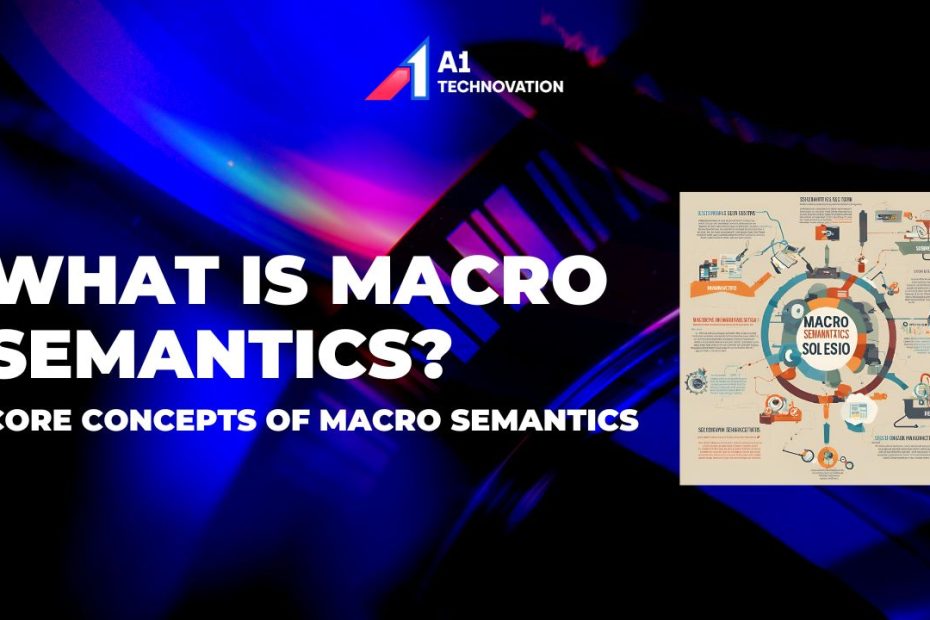Macro Semantics in SEO focuses on understanding and optimizing for the broader context and relationships among topics and keywords on a website. Unlike traditional SEO, which targets individual keywords, macro semantics considers the overall meaning, topical relevance, and user intent to improve search engine rankings and user experience. It aligns with how search engines like Google interpret and rank content, emphasizing the comprehensive understanding of topics.
Core Concepts of Macro Semantics
- Topic Clusters
- Contextual Relevance
- Semantic Keywords
- User Intent
- Content Depth and Breadth
- Internal Linking Structure
- Structured Data
- Content Hubs
Topic Clusters in Macro Semantics
Topic clusters involve structuring content around a central theme (pillar page) and supporting it with related subtopics (cluster content). This approach enhances the site’s authority on the topic and improves its SEO.
Detailed Example:
- Pillar Page: “Complete Guide to Digital Marketing”
- Cluster Content:
- Article 1: “SEO Basics”
- Article 2: “Content Marketing Strategies”
- Article 3: “Social Media Marketing”
- Article 4: “Email Marketing Tips”
- Each article within the cluster links back to the pillar page and to other related articles, creating a web of interconnected content that reinforces the main topic and helps search engines understand the breadth and depth of the subject.
- Cluster Content:
Contextual Relevance in Macro Semantics
Contextual relevance ensures that all content within a topic cluster is closely related and provides valuable information in the context of the main topic, improving user experience and search engine understanding.
Detailed Example:
- Pillar Page: “Benefits of Organic Farming”
- Cluster Content:
- Article 1: “Impact of Organic Farming on Soil Health”
- Article 2: “Organic Farming Techniques”
- Article 3: “Economic Benefits of Organic Farming”
- Each article is contextually tied to the pillar topic, ensuring comprehensive coverage of organic farming from various perspectives, thus meeting user needs and signaling to search engines the thematic relevance of the content.
- Cluster Content:
Semantic Keywords in Macro Semantics
Semantic keywords are terms and phrases related to the main keyword, providing a comprehensive coverage of a topic and enhancing content relevance.
Detailed Example:
- Main Keyword: “Artificial Intelligence”
- Semantic Keywords: “machine learning,” “neural networks,” “AI applications,” “natural language processing,” “deep learning.”
- Incorporating these semantic keywords into the content helps cover various aspects of AI, offering a richer and more complete understanding of the topic. This aids in matching the diverse ways users might search for information on AI.
User Intent in Macro Semantics
User intent focuses on understanding what users aim to achieve with their searches and tailoring content to meet those needs, enhancing relevance and satisfaction.
Detailed Example:
- Search Query: “How to lose weight”
- User Intent: Looking for actionable advice and methods.
- Content Response: Create comprehensive content that includes practical tips, exercise routines, diet plans, and success stories. This content addresses the informational and practical needs of users, making it more likely to satisfy their search intent and rank well in search results.
Content Depth and Breadth in Macro Semantics
Content depth and breadth involve creating comprehensive content that covers a topic extensively (depth) and includes various related subtopics (breadth), enhancing topical authority and user satisfaction.
Detailed Example:
- Topic: “Electric Vehicles (EVs)”
- Depth: Detailed articles on “EV technology,” “benefits of EVs,” “future trends in EVs.”
- Breadth: Additional content on related topics such as “charging infrastructure,” “government policies on EVs,” “comparisons with traditional vehicles,” and “environmental impact of EVs.”
- By covering a topic deeply and broadly, the content provides a thorough resource for users, increasing the likelihood of satisfying diverse user queries and ranking well in search engines.
Internal Linking Structure in Macro Semantics
Internal linking structure enhances the navigability and interconnection of content within a site, helping search engines understand the hierarchy and relationships between different pieces of content.
Detailed Example:
- Website Structure: A pillar page on “Digital Marketing” with links to cluster articles on “SEO,” “Content Marketing,” “Social Media,” etc.
- Internal Links: Articles on “SEO Tools” link to the “SEO Basics” article, which in turn links back to the “Complete Guide to Digital Marketing” pillar page. This interconnected structure helps search engines and users navigate the content, reinforcing the topical relevance and importance of the pillar page.
Structured Data in Macro Semantics
Structured data uses specific markups (like schema.org) to help search engines understand the content more effectively, often leading to enhanced search results like rich snippets.
Detailed Example:
- Recipe Website: Implementing structured data for recipes, including details like ingredients, cooking time, and ratings.
- Result: Search engines can display this structured information in search results, such as showing a rich snippet with a star rating, cooking time, and a list of ingredients directly in the search results, improving visibility and click-through rates.
Content Hubs in Macro Semantics
Content hubs are centralized areas on a website where related content is grouped, often around a specific theme or topic, providing a comprehensive resource for users and enhancing topical authority.
Detailed Example:
- Content Hub on “Home Renovation”:
- Sections Include:
- “Kitchen Remodeling”
- “Bathroom Upgrades”
- “DIY Home Projects”
- “Budget Planning”
- Each section links to detailed articles, guides, and resources, creating a one-stop hub for users interested in home renovation. This comprehensive approach improves user experience, keeps users engaged on the site longer, and signals to search engines the authority and relevance of the site on home renovation topics.
- Sections Include:
Conclusion
Macro semantics in SEO involves a holistic approach to content creation and optimization, focusing on the broader context and relationships among topics. By leveraging concepts such as topic clusters, contextual relevance, semantic keywords, user intent, content depth and breadth, internal linking, structured data, and content hubs, websites can improve their search engine rankings and provide better user experiences. This comprehensive strategy aligns with how modern search engines evaluate and rank content, ensuring long-term SEO success.

